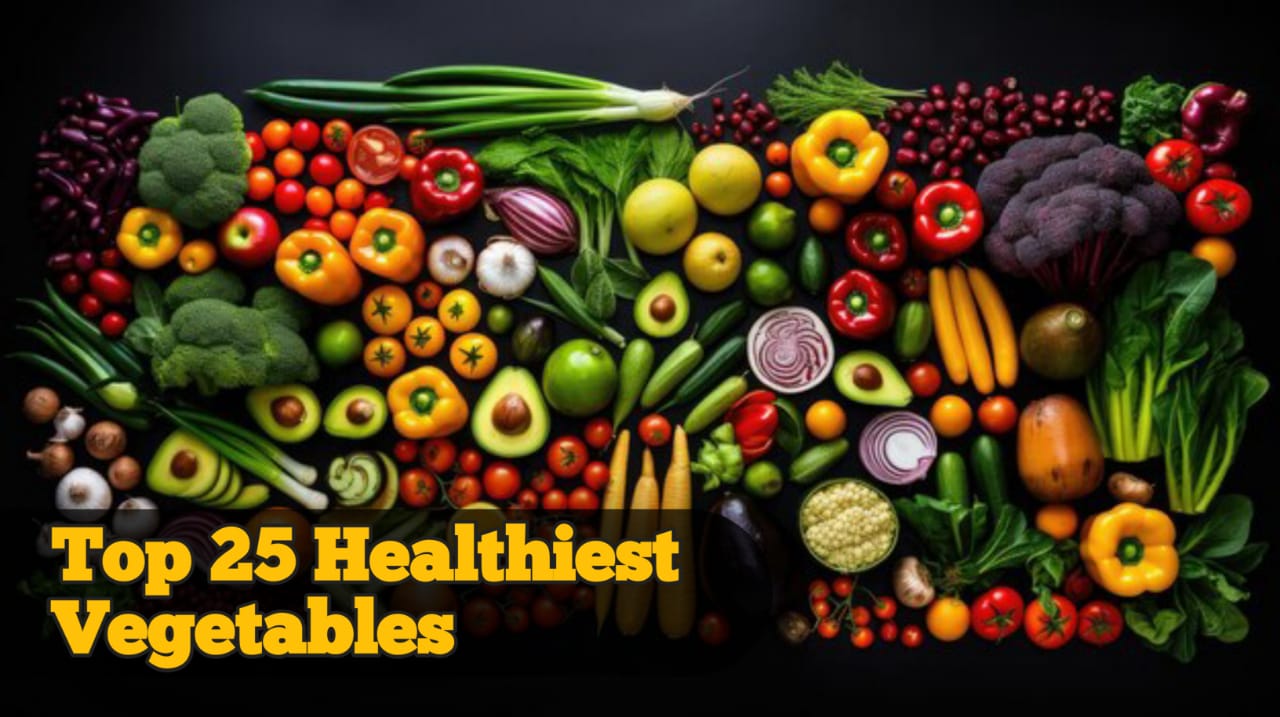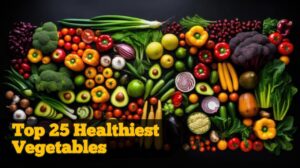Top 25 Healthiest Vegetables: You Should Be Eatings
Top 25 Healthiest Vegetables
Eating a colorful mix of vegetables is one of the best ways to keep yourself healthy. Loaded with vital vitamins, minerals, fiber, and antioxidants, veggies play a key role in boosting your immune system, enhancing digestion, and lowering the chances of chronic illnesses.
- Spinach
Why It’s Healthy: Spinach is packed with iron, calcium, vitamin K, and antioxidants like
lutein, which are fantastic for your eye health.
How to Eat: Toss it into salads, blend it into smoothies, or sauté it with some garlic for a
tasty side. - Kale
Why It’s Healthy: This superfood is bursting with vitamins A, C, K, and fiber, plus it has
cancer-fighting properties thanks to compounds like sulforaphane.
How to Eat: Bake it into crispy kale chips, blend it into your morning smoothie, or throw
it into salads for a nutritious crunch. - Broccoli
Why It’s Healthy: Broccoli is high in fiber and vitamin C, and it contains sulforaphane,
which might help in cancer prevention.
How to Eat: Steam it, roast it, or stir-fry it with other veggies for a delicious dish. - Carrots
Why It’s Healthy: Carrots are great for your eyes because they’re loaded with
beta-carotene, which your body converts into vitamin A.
How to Eat: Enjoy them raw, roast them, or juice them for a refreshing drink. - Sweet Potatoes
Why It’s Healthy: These are rich in vitamin A, fiber, and antioxidants that help boost your
immune system.
How to Eat: Bake them, mash them, or turn them into sweet potato fries for a tasty treat. - Brussels Sprouts
Why It’s Healthy: They’re high in fiber, vitamin K, and have compounds that may help
reduce inflammation.
How to Eat: Roast them with olive oil or shred them into salads for a crunchy addition. - Bell Peppers
Why It’s Healthy: Especially the red ones, bell peppers are loaded with vitamin C and
antioxidants.
How to Eat: Enjoy them raw, stuff them with quinoa, or sauté them in stir-fries for extra
flavor. - Garlic
Why It’s Healthy: Garlic contains allicin, which has antibacterial properties and is good
for your heart.
How to Eat: Use it in sauces, soups, or roast it to enhance the flavor of your dishes. - Beets
Why It’s Healthy: Beets can boost your stamina, lower blood pressure, and support liver
detox.
How to Eat: Roast them, juice them, or toss them into salads for a pop of color. - Cauliflower
Why It’s Healthy: It’s low in calories, packed with fiber, and a fantastic source
of choline, which is great for your brain.
How to Eat: You can make cauliflower rice, mash it up, or roast it for a
delicious side. - Asparagus
Why It’s Healthy: This veggie is loaded with folate, fiber, and vitamins A, C,
and K.
How to Eat: Try grilling, steaming, or tossing it into your omelets. - Cabbage
Why It’s Healthy: Cabbage is rich in cancer-fighting compounds and is
excellent for gut health.
How to Eat: You can ferment it into sauerkraut, stir-fry it, or use it in slaws. - Tomatoes
Why It’s Healthy: They’re rich in lycopene, which might help lower the risk of
heart disease.
How to Eat: Enjoy them fresh, roast them, or blend them into sauces. - Zucchini
Why It’s Healthy: Zucchini is low in carbs, high in water, and a great source of
vitamin C.
How to Eat: Spiralize it into noodles, grill it, or bake it for a tasty treat. - Green Peas
Why It’s Healthy: These little gems are high in protein, fiber, and vitamins A
and K.
How to Eat: Toss them into soups, salads, or stir-fries for a pop of color and
nutrition. - Swiss Chard
Why It’s Healthy: It’s packed with magnesium, iron, and vitamin K, all of which
are great for your bones.
How to Eat: Sauté it with garlic or throw it into soups for added flavor. - Onions
Why It’s Healthy: Onions are loaded with quercetin, an antioxidant that helps
fight inflammation.
How to Eat: You can caramelize them, sauté them, or enjoy them raw in
salads. - Eggplant
Why It’s Healthy: Eggplant contains nasunin, an antioxidant that protects your
brain cells.
How to Eat: Grill it, bake it, or whip up some eggplant parmesan for a hearty
dish. - Celery
Why It’s Healthy: It’s low in calories, super hydrating, and great for digestion.
How to Eat: Snack on it raw with hummus, juice it, or add it to soups. - Artichokes
Why It’s Healthy: These little guys are packed with fiber, making them
fantastic for your gut health.
How to Eat: You can steam them and enjoy with your favorite dips, or toss
them into salads for a tasty crunch. - Pumpkin
Why It’s Healthy: Pumpkins are loaded with beta-carotene, fiber, and vitamin
C—talk about a nutritional powerhouse!
How to Eat: Roast them, whip up a comforting soup, or blend into smoothies
for a delicious treat. - Radishes
Why It’s Healthy: Radishes are great for your liver and digestion, thanks to
their detoxifying properties.
How to Eat: Slice them up for salads or try pickling them for a zesty addition. - Cucumber
Why It’s Healthy: Cucumbers are super hydrating and rich in silica, which is
great for your skin.
How to Eat: Enjoy them fresh, toss them in salads, or infuse your water for a
refreshing twist. - Mushrooms
Why It’s Healthy: These fungi can give your immune system a boost and are a
good source of vitamin D when they soak up some sunlight.
How to Eat: Sauté, grill, or throw them into soups for added flavor. - Arugula
Why It’s Healthy: Arugula is high in nitrates, which might help improve blood
flow and enhance your workout performance.
How to Eat: Sprinkle it on salads, pizzas, or sandwiches for a peppery kick.









Post Comment